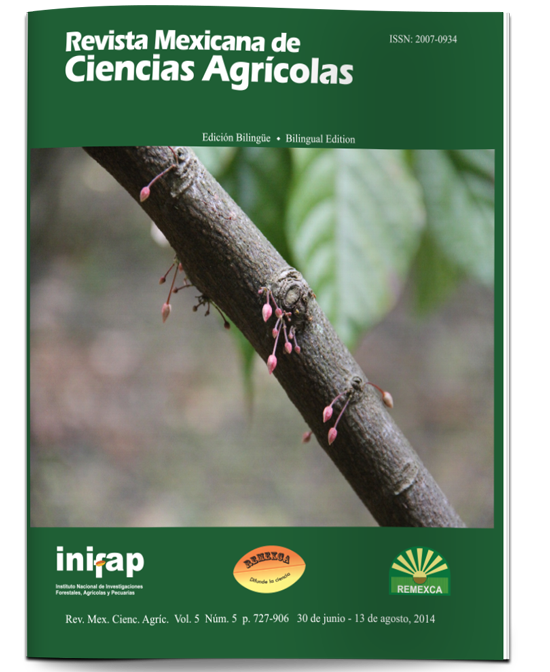Osmoprotectants content, ascorbic acid and ascorbate peroxidase on bean leaves under drought stress
DOI:
https://doi.org/10.29312/remexca.v5i5.907Keywords:
antioxidant activity, Phaseolus vulgaris L., moisture deficit, osmotic regulatorsAbstract
The accumulation of osmoprotectants in plants that are under stress from drought, allow you to offset the negative effect that causes these environmental conditions. In this study the biochemical response of bean plants based on the accumulation of soluble carbohydrates, starch, ascorbic acid, and the activity of ascorbate peroxidase enzyme, simple leaves and the first two leaves trifoliolate of studied resistant variety, Pinto Villa, and susceptible to drought Bayo Madero, both of Durango race. Plants from two varieties were subjected to three moisture treatments, irrigation and irrigation drought recovery. Regarding Bayo Madero, Pinto Villa showed increased stress tolerance response related humidity: high concentrations of proline, ascorbic acid, and increased activity of the peroxidase enzyme ascorbate, the latter in the drying treatment. In relation to the amount of soluble carbohydrates, Bayo Madero was statistically superior (p< 0.05) to Pinto Villa, which may indicate that these compounds are being used by the plant to synthesize other compounds as osmoprotectants proline and which can be regarded as indicators important to classify plant species to survive and fulfill their life cycle under conditions of moisture stress.
Downloads
Downloads
Published
How to Cite
Issue
Section
License
The authors who publish in Revista Mexicana de Ciencias Agrícolas accept the following conditions:
In accordance with copyright laws, Revista Mexicana de Ciencias Agrícolas recognizes and respects the authors’ moral right and ownership of property rights which will be transferred to the journal for dissemination in open access. Invariably, all the authors have to sign a letter of transfer of property rights and of originality of the article to Instituto Nacional de Investigaciones Forestales, Agrícolas y Pecuarias (INIFAP) [National Institute of Forestry, Agricultural and Livestock Research]. The author(s) must pay a fee for the reception of articles before proceeding to editorial review.
All the texts published by Revista Mexicana de Ciencias Agrícolas —with no exception— are distributed under a Creative Commons License Attribution-NonCommercial 4.0 International (CC BY-NC 4.0), which allows third parties to use the publication as long as the work’s authorship and its first publication in this journal are mentioned.
The author(s) can enter into independent and additional contractual agreements for the nonexclusive distribution of the version of the article published in Revista Mexicana de Ciencias Agrícolas (for example include it into an institutional repository or publish it in a book) as long as it is clearly and explicitly indicated that the work was published for the first time in Revista Mexicana de Ciencias Agrícolas.
For all the above, the authors shall send the Letter-transfer of Property Rights for the first publication duly filled in and signed by the author(s). This form must be sent as a PDF file to: revista_atm@yahoo.com.mx; cienciasagricola@inifap.gob.mx; remexca2017@gmail.
This work is licensed under a Creative Commons Attribution-Noncommercial 4.0 International license.



